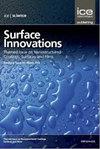Suppression of Leidenfrost instability of a large drop using multiple rods and rectangular mesh elements
IF 3.5
4区 材料科学
Q3 CHEMISTRY, PHYSICAL
引用次数: 0
Abstract
Large Leidenfrost drops may be unstable when their diameters exceed a critical value. Via theoretical and experimental investigations, this study explored the feasibility of suppressing Leidenfrost instability in a large container, by meshing the container or its central portion into rectangular elements. Thin rods were used to construct these rectangular elements. Thin rods were used to construct these rectangular elements. Leidenfrost instability was considered in four rectangular configurations. They were also the rectangular mesh elements that might be used. There were two findings. First, the diameter of the largest inscribed cylinder in a rectangular configuration was the critical dimension to determine Leidenfrost instability. Second, the threshold value of this diameter in a rectangular configuration with rod(s) was 8.9 ± 0.7λ, where λ was the capillary length of water. It was larger than its counterparts in both a rectangular container (without the presence of a rod) and a circular container (with or without the presence of a rod), due to the strong effect of the rod in a rectangular configuration. Based on these two findings, a large rectangular container was meshed into rectangular elements using thin rods, with the diameter of the largest inscribed cylinder in each element below the threshold value. This mesh method suppressed the Leidenfrost instability in the large container.用多杆和矩形网格单元抑制大液滴的Leidenfrost不稳定性
当直径超过临界值时,大型雷氏液滴可能不稳定。通过理论和实验研究,本研究探索了通过将容器或其中心部分网格化为矩形单元来抑制大型容器中Leidenfrost不稳定性的可行性。细杆被用来构造这些矩形元件。细杆被用来构造这些矩形元件。Leidenfrost不稳定性是在四个矩形配置中考虑的。它们也是可能使用的矩形网格元素。有两个发现。首先,矩形结构中最大内切圆柱的直径是确定莱登弗罗斯特不稳定性的关键尺寸。其次,在具有棒的矩形配置中,该直径的阈值为8.9±0.7λ,其中λ是水的毛细管长度。它比矩形容器(不存在杆)和圆形容器(有或没有杆)中的对应物都大,这是因为在矩形配置中杆的强大作用。基于这两个发现,使用细杆将一个大型矩形容器网格化为矩形单元,每个单元中最大内切圆柱的直径低于阈值。这种网格方法抑制了大型容器中的Leidenfrost不稳定性。
本文章由计算机程序翻译,如有差异,请以英文原文为准。
求助全文
约1分钟内获得全文
求助全文
来源期刊

Surface Innovations
CHEMISTRY, PHYSICALMATERIALS SCIENCE, COAT-MATERIALS SCIENCE, COATINGS & FILMS
CiteScore
5.80
自引率
22.90%
发文量
66
期刊介绍:
The material innovations on surfaces, combined with understanding and manipulation of physics and chemistry of functional surfaces and coatings, have exploded in the past decade at an incredibly rapid pace.
Superhydrophobicity, superhydrophlicity, self-cleaning, self-healing, anti-fouling, anti-bacterial, etc., have become important fundamental topics of surface science research community driven by curiosity of physics, chemistry, and biology of interaction phenomenon at surfaces and their enormous potential in practical applications. Materials having controlled-functionality surfaces and coatings are important to the manufacturing of new products for environmental control, liquid manipulation, nanotechnological advances, biomedical engineering, pharmacy, biotechnology, and many others, and are part of the most promising technological innovations of the twenty-first century.
 求助内容:
求助内容: 应助结果提醒方式:
应助结果提醒方式:


